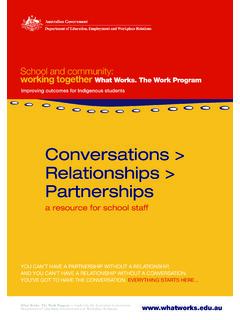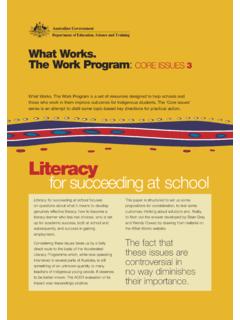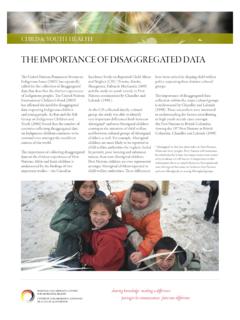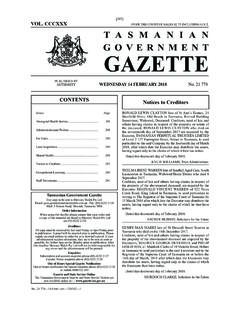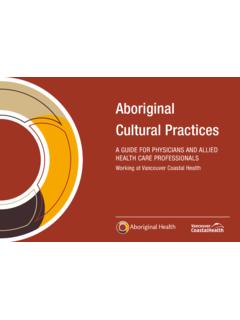Transcription of A research study of eleven improving remote schools
1 improving outcomes for Indigenous students Success in remote schools A research study of eleven improving remote schools 1 28/6/12 1:01:54 PM. What Works. The Work Program. Success in remote schools : a research study of eleven improving remote schools 1st edition Published by National Curriculum Services Pty Ltd Contact details: National Curriculum Services, PO Box 361, Abbotsford VIC 3067, Phone +61 3 9415 1299. July 2012. ISBN 978-1-875864-73-7. Commonwealth of Australia 2012. This work is copyright. It may be reproduced in whole or in part for training purposes subject to the inclusion of an acknowledgment of the source and no commercial usage or sale. Every endeavour has been made to contact copyright holders to obtain the necessary permission for use of illustrative/copyright material in these materials. Any person who may inadvertently have been overlooked is invited to contact the publishers. The views expressed in this publication do not necessarily represent the views of the Australian Government Department of Education, Employment and Workplace Relations.
2 Printed by Total Print, Campbellfield 2 28/6/12 1:01:54 PM. Contents improving outcomes for Indigenous students Foreword 3. Executive summary 5. research project overview 9. The schools 11. Seven common high-frequency themes 17. 1. Leadership is critical 20. 2. Profound understanding of the importance of school community partnerships 27. 3. A school culture built on high expectations for all students 32. 4. Coherent whole- school approaches to evidence-based literacy and numeracy teaching 37. 5. Building and sustaining teacher capacity to deliver whole- school practice 46. 6. Empowering, supporting and engaging Aboriginal and Torres Strait Islander students to enhance their learning capacity 53. 7. Making learning content engaging, accessible and culturally responsive 59. Improvement pathways 61. Transferability 63. Bibliography 64. Endnotes 64. Acronyms used in this publication ACER Australian Council for Educational research AEO Aboriginal Education Officer AEW Aboriginal Education Worker AICS Aboriginal Independent Community school AIEO Aboriginal and Islander Education Officer APY Anangu Pitjantjatjara/Yankunytjatjara DEEWR Department of Education.
3 Employment and Workplace Relations EAL/EAD English as an Additional Language/English as an Additional Dialect ICSEA Index of Community Socio-Educational Advantage ICTs information and communication technologies IEW Indigenous Education Worker NAPLAN National Assessment Program Literacy and Numeracy NARIS National Alliance for remote Indigenous schools NCS National Curriculum Services NTCET Northern Territory Certificate of Education PBL Positive Behaviour Learning PLCs professional learning communities PLP Personalised Learning Plan PYEC Pitjantjatjara/Yankunytjatjara Education Committee RSCAM remote schools Curriculum and Assessment Materials SBA school -based Apprenticeship SIDE schools of Isolated and Distance Education SAE Standard Australian English VET vocational education and training Foreword I am pleased to introduce this report of the What Works research into success in remote schools . The What Works team from National Curriculum Services undertook this research in eleven remote schools .
4 These and many other remote schools are doing great work and achieving success under circumstances that are often very challenging. It is important that we share their strategies with other schools so that they can benefit from this experience. The findings presented in this report are valuable because they offer unique insights into the practices and behaviours that have resulted in improved outcomes. They reinforce the things we know work well, like the importance of: strong school leadership;. quality teaching and workforce development;. adopting a high expectations culture; and engaging with parents and others in the local community. These factors were built into the Aboriginal and Torres Strait Islander Education Action Plan because educators and communities told Education Ministers how important they were. What Works shows us that schools are implementing these factors in different ways to suit their local circumstances. I hope that through reading about the journey of these eleven schools , educators and communities will be inspired in their own journey to build bright futures for Aboriginal and Torres Strait Islander students.
5 This research contributes to a growing evidence-base of what works to get better outcomes in remote schools . I congratulate the What Works team for its work and commend the report to all with an interest in closing the gap between the educational outcomes of Aboriginal and Torres Strait Islander students and those of other Australian students. Peter Garrett AM MP. Minister for school Education, Early Childhood and Youth July 2012. What Works. The Work Program 3. 4 Success in remote schools : a research study of eleven improving remote schools Executive summary remote and very remote schools face significant challenges in attaining outcomes for Aboriginal and Torres Strait Islander students that are commensurate with all students. A critical aspect of the challenge is getting the mix of factors that influence Aboriginal and Torres Strait Islander student outcomes together in a balanced, comprehensive and sustainable manner in a remote context. W.
6 Hile the challenges are significant, achieving outcomes that at least mirror those for there are schools in remote the state or territory. They recognise and value and very remote Aboriginal the importance of incorporating student cultural and Torres Strait Islander identity in school operations, in particular into communities that record successful outcomes teaching and learning. They combine their beliefs, for their students. This study reports on eleven remote or very remote schools located in South Australia, Western Australia, Northern Territory, Queensland and New South Wales. Ten were It is clearly evident that school identified by the National Alliance for remote leadership, especially that of the Indigenous schools (NARIS) as improving principal, performs a critical role schools . The eleventh school was nominated by the Aboriginal Independent Community in the improving outcomes. schools of Western Australia. The schools had demonstrated sustained improvement in National Assessment Program Literacy and Numeracy goals and values with effective instructional (NAPLAN) literacy and/or numeracy outcomes leadership by guiding, supporting, directing and and attendance rates.
7 Sustaining improvement in whole- school practices and Aboriginal and Torres Strait Islander student What Works researchers visited each school to outcomes. While each of the principal's actions observe and identify the practices the schools are similarly focused and extensive, each of them use to influence the various community, school , simply views him or herself as performing the role classroom, teacher and student-level factors that of a principal. The principal's role can be seen in have potentially contributed to their improved all of the common strategies and high-frequency performance. actions discussed in this report. Some common themes encapsulating the high- Of course they cannot do it alone. Profound frequency actions used among the schools emerged approaches to school family community from the information gathered. partnerships are evident in each of the eleven It is clearly evident that school leadership, schools . The two-way dialogue observed between especially that of the principal, performs a critical school and community is evidence of the depth role in the improving outcomes.
8 In all eleven of understanding and respect in the relationships. schools principals' actions are guided by a core At each school the dialogue is based on shared belief in the learning capacity of their Aboriginal assumptions: that school and community cultures and Torres Strait Islander students. They are not have much to learn from each other; and that satisfied by their students performing at levels Aboriginal and Torres Strait Islander and non- around those for similar schools and aim for Indigenous ways of thinking, learning and What Works. The Work Program 5. communicating should be respected in decision learning. The primary emphasis of these strategies making. Engaging in authentic two-way dialogue and actions is to influence teacher capacity and with families and community has created a shared practice to deliver the whole- school pedagogical vision for students and agreed ways of achieving it. approaches developed by each school . They involve a mix of teacher support and accountability A universal observation emerging from the eleven mechanisms such as professional learning, schools is that each has built a school culture performance planning, and coaching and modelling.
9 Focused on high expectations for Aboriginal and Torres Strait Islander students. These cultures Students are undoubtedly at the centre of activity include: in all of the eleven schools . Another set of high- frequency interventions observed in the schools strong, shared core beliefs about Aboriginal is designed to respond to specific student-level and Torres Strait Islander students and factors viewed as critical by the schools in learning;. supporting literacy and numeracy achievement of shared vision statements that describe high their students. These interventions are designed to expectations of student outcomes; include, engage and support Aboriginal and Torres agreed norms based on positive relationships Strait Islander students and enhance their capacity among all involved in student learning; and to learn. They include: a strategic orientation complemented by a targeted attendance building;. focused and manageable improvement agenda. transition and pathways programs at various High expectations are not confined to students; stages of learning.
10 They applied equally to all the adults involved in parent relationships and meetings;. the schools . Personalised Learning Plans (PLPs);. Each of the schools has established whole- school Special Education services, addressing student approaches to literacy and numeracy teaching health and wellbeing factors; and that describe an instructional model expected to be seen in each classroom. These models include an array of other initiatives. a common classroom and lesson sequence or These common strategies and high-frequency routine, covering steps such as: actions are grouped into seven themes emerging revision of previous learning; from the research project (see Figure 1). discussion of learning intentions for the class; The seven themes do not represent discrete stand- alone strategies. In effect, what was observed in the use of whole-class and small group the schools was a coherent and comprehensive set learning; and of strategies and actions designed to act on various lesson conclusions involving whole-class review levels, all intended to improve student learning.

